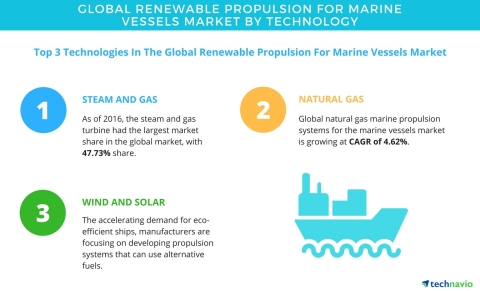Renewable Propulsion for Marine Vessels Market - High Demand for COGAS to Boost Market Growth | Technavio
According to the latest market study released by Technavio,
the global renewable propulsion for marine vessels market is
expected to grow at a CAGR of close to 5% during the forecast period.
This press release features multimedia. View the full release here:
http://www.businesswire.com/news/home/20171031006392/en/

Technavio has published a new report on the global renewable propulsion for marine vessels market from 2017-2021. (Graphic: Business Wire)
This research report titled ‘Global
Renewable Propulsion for Marine Vessels Market 2017-2021’ provides
an in-depth analysis of the market in terms of revenue and emerging
market trends. This report also includes an up to date analysis and
forecasts for various market segments and all geographical regions.
This report is available at a USD 1,000 discount for a limited time
only: View
market snapshot before purchasing
Buy 1 Technavio report and get the second for 50% off. Buy 2
Technavio reports and get the third for free.
The market research analysis categorizes the global renewable
propulsion for marine vessels market into three major technology
segments. They are:
-
Steam and gas turbine
-
Natural gas
-
Wind and solar
Looking for more information on this market? Request
a free sample report
Technavio’s sample reports are free of charge and contain multiple
sections of the report including the market size and forecast, drivers,
challenges, trends, and more.
Global steam and gas turbine propulsion for marine vessels market
The combined gas and steam turbine (COGAS) propulsion system is one of
the most efficient alternative power-driven propulsion systems for naval
and commercial ships, which offers significant advantages over steam and
diesel propulsion. The system allows faster movement of ships, and fuel
efficiency is balanced with the steam propulsion system. In addition,
its power output is higher than other non-renewable fuels.
According to Moutushi Saha, a lead analyst at Technavio for defense
research, “COGAS systems maximize the operational efficiency when
combined with other propulsion systems, such as diesel engines. Though
the market for future ship propulsion systems is shifting toward
all-electric concepts, gas turbines will remain the reliable source to
produce electricity.”
Global natural gas marine propulsion systems for marine vessels market
As the maritime industry aims to shift away from diesel and petroleum
fuel, natural gas projects will emerge as a viable option in multiple
sectors, including shipping. Various experiments have been conducted in
the last 15 years, which have proved the viability of LNG-powered marine
vessels and its potential to reduce greenhouse gases (GHG) emissions. As
the availability of large domestic shale reserves in the US has reduced
the LNG prices to lesser than that of diesel, the adoption of LNG is
expected to yield a reduction in operational expenses as well.
“The shipping sector favors the use of LNG owing to its low carbon
emissions, and a suitable network is rapidly evolving on established
transport routes to support the development of such renewable propulsion
infrastructure. In addition to natural gas, liquid biomethane can also
be used as a transport fuel,” says Moutushi.
Global wind and solar energy propulsion systems for marine vessels
market
With the accelerating demand for eco-efficient ships, manufacturers are
focusing on developing propulsion systems that can use alternative
fuels. In 2015, a Norwegian engineer came up with a new cargo ship,
Vindskip, which is powered by wind and natural gas. It features software
that controls the use of alternative fuels in the propulsion system and
ensures an optimum use of wind energy.
The photovoltaic cells setup on board ships capture and store solar
power and enable a long durability for the sailplanes. Tests conducted
on a 150 miles four-day summer journey, which resulted in the
consumption of 106 kWh of electric energy, showed that 4% of the total
energy was supplied by the solar panel. Similarly, in 2016,
approximately three million solar panels and 3.87 million wind turbines
were installed on the decks of several ships to capture and store energy.
The top vendors highlighted by Technavio’s market research analysts in
this report are:
-
Deltamarin
-
Eco Marine Power (EMP)
-
Eniram (Wärtsilä)
-
Norsepower
-
Smart Green Shipping Alliance (SGSA)
Browse Related Reports:
About Technavio
Technavio
is a leading global technology research and advisory company. Their
research and analysis focuses on emerging market trends and provides
actionable insights to help businesses identify market opportunities and
develop effective strategies to optimize their market positions.
With over 500 specialized analysts, Technavio’s report library consists
of more than 10,000 reports and counting, covering 800 technologies,
spanning across 50 countries. Their client base consists of enterprises
of all sizes, including more than 100 Fortune 500 companies. This
growing client base relies on Technavio’s comprehensive coverage,
extensive research, and actionable market insights to identify
opportunities in existing and potential markets and assess their
competitive positions within changing market scenarios.
If you are interested in more information, please contact our media team
at media@technavio.com.

View source version on businesswire.com: http://www.businesswire.com/news/home/20171031006392/en/
Copyright Business Wire 2017






